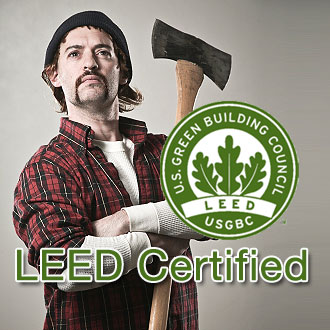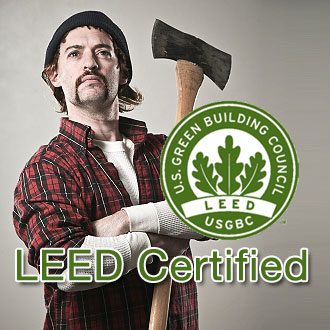 The green building gurus must have spit their coffee across the table when they saw the full-page ad in the Toronto Star this week. The U.S. Green Building Council and its Canadian sister organization had rallied hundreds of architects and developers to the city for their annual love-in, Green Build. Forest conservation groups seized the opportunity to plant ads in the local paper, with the USGBC logo photoshopped to read “U.S. GreenWASH Building Council.”
The green building gurus must have spit their coffee across the table when they saw the full-page ad in the Toronto Star this week. The U.S. Green Building Council and its Canadian sister organization had rallied hundreds of architects and developers to the city for their annual love-in, Green Build. Forest conservation groups seized the opportunity to plant ads in the local paper, with the USGBC logo photoshopped to read “U.S. GreenWASH Building Council.”
OK, not the cleverest of PR ploys. (We’ll have to reserve that title for one of PETA’s many gags.) But it had to smart just a little.
So what’s up? “They’re on the brink of taking the second E out of LEED,” says Todd Paglia, executive director of the nonprofit Forest Ethics. (For those who haven’t been paying attention, LEED stands for Leadership in Energy and Environmental Design. Created by the Green Building Council, it’s the most widely accepted measure of a building’s greenness in the states right now.) Well, Paglia clarified, “LEED will at least be irrelevant as far as forests are concerned.”
He’s referring to proposed changes to the rules that would, he and other green groups argue, allow developers to use just about any old two-by-fours — including wood “from some of the worst clearcuts in North America” — and still get their houses LEED certified (as long as they still meet the gazillion other requirements, of course).
Up to now, the LEED rules have given points (“credits” in green building speak) to homebuilders who use lumber that is certified by the nonprofit Forest Stewardship Council (FSC), which ensures that the trees were grown and harvested sustainably. The new rules could allow builders to get points for lumber that is certified through other less strict outfits, such as the timber-industry-backed Sustainable Forestry Initiative — and, the greens argue, wood that is not certified at all.
But don’t think this is just about forests, ‘cause it’s not. It’s also about money, and keeping sustainable logging operations in business. You see, the market for certified lumber was limited in the days before every developer dreamed of having the LEED stamp of approval (which comes in silver, gold, or platinum, depending on how groovy the building is). LEED has helped pump up demand for FSC-certified wood.
But if the new rules open the playing field to any schmoe with a green Husqvarna hat, the truly forest-friendly timber outfits would take a serious hit. Paglia says it’s reminiscent of the debate over the U.S. organic standards nine years ago, when small farmers watched in horror as Big Ag tried to allow irradiation and sewage sludge and all manner of industrial nastiness in “Certified Organic” food production.
The Green Building Council takes great exception to all this, of course. Brendan Owens, the council’s vice president of LEED technical development, points out that there’s no rule against using clearcut wood in your LEED-certified house right now. You’re not going to score any points for your old-growth Douglas fir trim, but if you do everything else right, you still might earn the badge of approval. (In fact, clearcutting is even allowed under the Forest Stewardship Council’s guidelines, though there are strict rules for protecting streams and wildlife.)
Owens explains that the proposed changes to the rules are meant to take what the council has learned about sustainable timber and apply them to all the other materials that go into a new house or office building, including concrete, glass, and steel. Much of the steel used in the U.S. is mined in Brazilian rainforests, then shipped to China for processing before being floated across the ocean yet again to get to U.S. markets. Meanwhile, much of the steel still being produced in the U.S. is recycled.
“The effort and the oxygen that we’ve spent talking about [timber certification] has been extraordinarily valuable, but we’ve largely allowed the other industries to go unnoticed,” Owens says. “It’s not OK.”
Good on them for trying to clean up other industries, says Paglia, but that’s no excuse for lowering the standards for sustainable wood. “The rub here is that [the Green Building Council is] focusing on LEED becoming a large part of the market, instead of LEED producing really sustainable buildings,” he says.
The proposed changes to the LEED rules will go out for another round of public comment this year. The Green Building Council hopes to unveil the final rules at Green Build 2012, in San Francisco.
Side note: For those who really want to build the ultimate eco-house, you now have yet another standard to work with: At the conference this week, the International Living Future Institute rolled out its new Net Zero Energy Building Certification. This one is for houses that use no fossil fuels for heating, cooling, or electricity. (David Gottfried, founder of the U.S. Green Building Council, owns a “net zero” home, and claims it’s the greenest home in America.) No word yet on whether this certification comes in all kinds of fancy colors, but for now, at least, it looks like you’ll probably just get a straight pass or fail.



